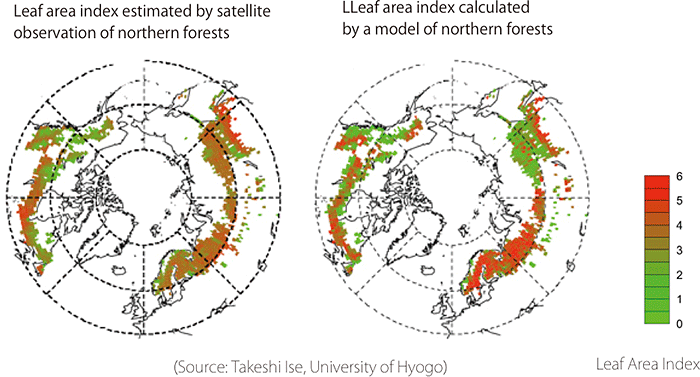Strategic Research Target ②
Understanding the Arctic system for global climate and future change
Principal Investigator: Atsuko Sugimoto (Hokkaido University)
Arctic climate change is spreading globally
The Arctic environment is rapidly changing, and the changes are spreading throughout the entire world like ripples, carried by atmospheric and oceanic circulation. A better understanding of the current change in the Arctic environment and its effect on global climate change is required for a more accurate prediction of global climate change and of our future.
In order to achieve strategic research target ②, Understanding the Arctic system for global climate and future change, we are working on the following five research projects.
(1) Improvement of coupled general circulation models based on validations of Arctic climate reproducibility and on mechanism analyses of Arctic climate change and variability
(2) Change in the terrestrial ecosystems of the pan-Arctic and effects on climate
(3) Atmospheric studies on Arctic change and its global impacts
(4) The role of Arctic cryosphere in global change
(5) Studies on greenhouse gas cycles in the Arctic and their responses to climate change
The Arctic infl uences global warming
Project (5), which addresses greenhouse gases has been added to research projects (1) to (4), which are common to strategic research target ①. The increase in concentrations of greenhouse gases, such as carbon dioxide and methane, is accelerating warming. In this 100-year period, the average global air temperature has risen by about 0.74℃, and it is highly possible that the increase in greenhouse gases from manmade sources is a factor.
How will this warming progress in the future? The role of the Arctic region is crucial when we consider this aspect. As a result of the rapid warming of the Arctic, the area of sea ice and snow cover has been decreasing. The warming of the Arctic is believed to be progressing as a result of changes in the land surface and the circulation of energy, water, and other materials. Moreover, the rise in air temperature is beyond a doubt thawing the permafrost. As the permafrost thaws gradually, the methane and organic matter trapped within its ice are released. The decomposition of this organic matter is thought to increase the amount of greenhouse gases released into the atmosphere. Changes in soil temperature and soil moisture alter the rate of plant growth and the species of plants. Changing the state of the land surface alters the behavior of energy, water, and material cycles, and may in turn trigger further changes. The extensive wetlands of the Arctic region naturally release methane (a potent greenhouse gas) into the atmosphere; however the rise in soil temperature and the changes in the vegetation will increase the amount of methane released, which may accelerate global warming.
The necessity of a global climate model
Global climate models are currently used to predict climatic changes over the entire world. Unfortunately, these models do not sufficiently take into account changes in snow cover, permafrost and vegetation, and so they can not produce forecasts with a high degree of accuracy. We simply do not sufficiently understand how the snow cover, permafrost, vegetation and greenhouse gases are changing as a result of the warming of the Arctic region. The first step is to understand these changes by making observations, and to develop models that take into account the changes taking place on land.
In Greenland, located in the Arctic region, the ice sheets are rapidly decreasing. The melting of the ice sheets causes sea levels to rise. The area off the coast of Greenland is a starting point for general circulation of the ocean because the seawater there cools, becomes heavier and sinks deep below. The fresh water running off from the melting ice sheets into the ocean lowers the density of the surrounding seawater and could therefore weaken the general circulation of the ocean. This would trigger tremendous climate change on a global scale. Nevertheless, current global climate models do not sufficiently take into account the changes in ice sheets and glaciers. We will get an insight into these changes through our observations, and will develop models for sea level change.
Expected results
Development of models for changes in the land system and models for changes in sea level is expected to enable scientists to quantify the changes to various factors, such as snow cover, frozen soil, vegetation, greenhouse gases, ice sheets, glaciers and sea levels, which are strongly affected by Arctic climate change. By incorporating these elements into global climate models, our research on the Arctic system will contribute to enhance predictions, not only for the Arctic, but also for the global climate in the future.


